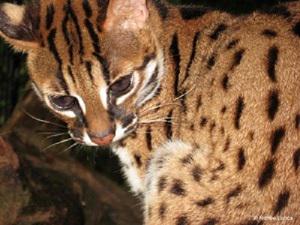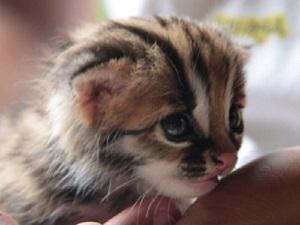Ma. Renee P. Lorica
This proposed study aims to investigate the spatial ecology of the Visayan leopard cat to elucidate how these cats ‘share’ the landscape with humans, improve on methods on studying the ecology of small felids, and will become the basis for the formulation of relevant management plans for the protection of remnant habitats for the native wildlife of Negros surviving in human‐dominated landscapes.

Visayan leopard cat, Prionailurus bengalensis rabori.
Almost all currently available information on the natural history of the Visayan leopard cat has been obtained from observations on hand‐reared captives acquired through donations and confiscations in a rescue centre in Bacolod City, Negros Occidental. What little is known about the species in the wild has been derived from the anecdotal accounts of local hunters, canecutters and other informants. The lack of ecological data on wild populations is not surprising given the general scarcity of these animals and their naturally cryptic lifestyle coupled with the inaccessibility and extreme ruggedness of terrain supporting most of the few remaining native forests.

Visayan leopard cat kitten.
Nonetheless, more information is needed to assess levels of threat and assist formulation of conservation management plans particularly in and around native forest fragments. There is also an urgent need to work with cane‐farm owners and managers to promote the conservation of leopard cat populations in sugar cane farms where they undoubtedly play a beneficial role in helping to control rodents. The leopard cat’s contribution to rodent control within agricultural landscapes namely oil palm plantations has been previously reported for both the Bornean subspecies (P.b. borneoensis, Rajaratnam 2000; Rajaratnam and others 2007) and the Sumatran subspecies (P. b. sumatranus, Scott and Gemita 2004).
Furthermore, leopard cat populations in sugar cane farms are also likely to constitute a significant percentage of the total surviving population of leopard cats in the West Visayas. Moreover, and for all practical purposes, many aspects of the Visayan leopard cat ecology can be readily studied especially through radiotelemetry in sugar cane farms compared to remnant forest patches in remote and extremely rugged terrain. Given the current, significant threat to leopard cat survival in sugar cane plantations, crucial ecological information on social and spatial organization, activity patterns, and habitat use is urgently needed to formulate workable conservation, management and education programs for this subspecies.
This proposed study aims to investigate the spatial ecology of this particular felid through radio telemetry and the use of indirect detection indices in occupancy modelling. These methods will be combined to elucidate how leopard cats ‘share’ the landscape with humans, improve on methods on studying the ecology of small felids, and will become the basis for the formulation of relevant management plans for the continued existence of leopard cats and other native wildlife in the cane fields of Negros.